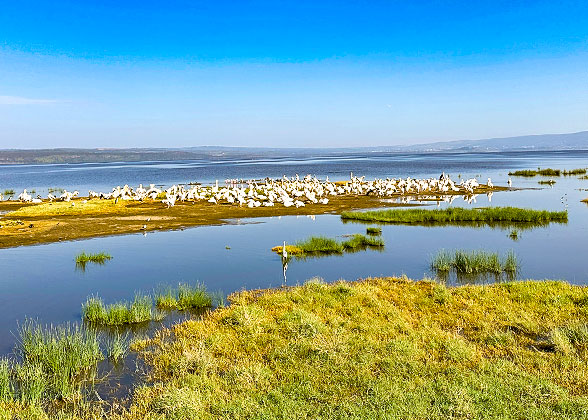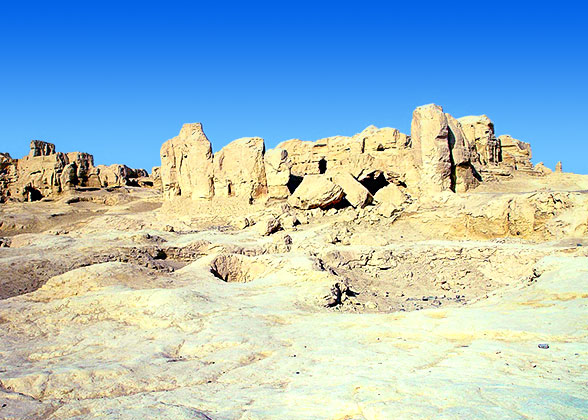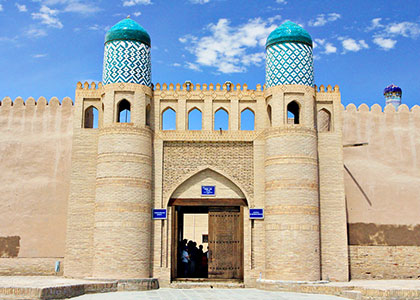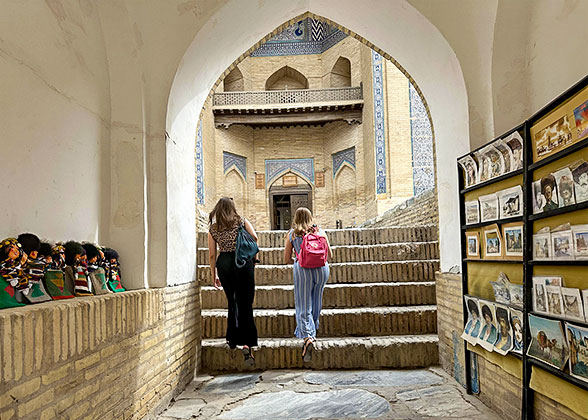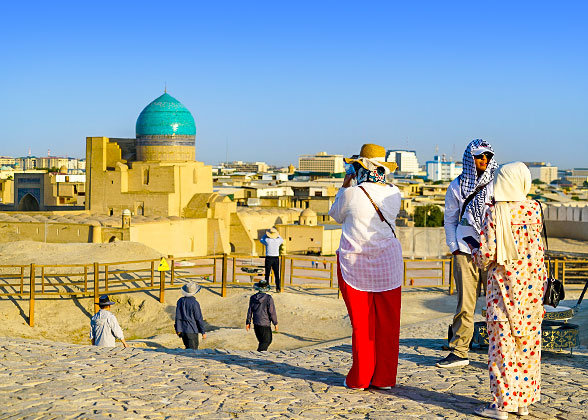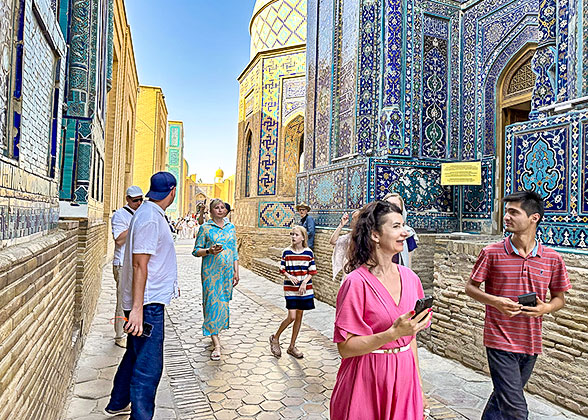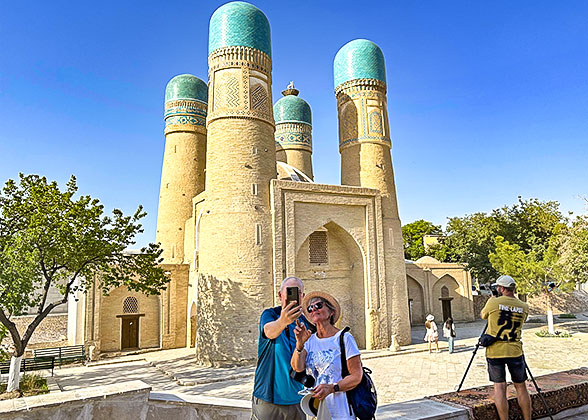Day 1: Tashkent Hotel Pick-up, Fly to Nukus: Savitsky Karakalpakstan Art Museum & Mizdakhan Necropolis
Uzbek Samsa Welcome to take the Uzbekistan private tours starting from Tashkent! This morning, the driver in Tashkent will pick you up at the hotel you booked in the city and transfer you to the airport. After about 1.5 hours, you’ll arrive at Nukus, Uzbekistan’s sixth-largest city, perched on the western frontier, which served as a strategic bulwark during the Khwarezmian Empire (1077-1231) in the 4th century. As soon as you land, our local driver will escort you to the Savitsky Karakalpakstan Art Museum. Follow the English-speaking museum guide we arranged for you to explore preserved Soviet avant-garde artworks and vibrant Karakalpak folk artifacts. The museum was founded in 1966 by a Moscow artist who secretly gathered over 90,000 pieces of artwork banned by the Soviet authorities and created this “Louvre of Uzbekistan”. Among its treasures, The Bull is the most prized, in which the blue animal looks straight at the visitors with its black inane eyes. Beyond paintings, you can see wooden sculptures, Nukus traditional clothes, and jewelry. After a 30-minute drive, we’ll arrive at the 4th-century BC Mizdakhan Necropolis, one of the oldest and largest cemeteries of Karakalpakstan, an autonomous administrative region of Uzbekistan. Mizdakhan was once a thriving city, but was destroyed by Timur in the 14th century and gradually became a dead place, scattered with numerous dilapidated mosques and tombs. The tomb of the princess on the eastern hill is one of the well-preserved buildings. Stepping in, you’ll be dazzled by the azure domes resembling the sky when the light streams through the windows and shimmers on their glazed surface. Among the graves, you can also find various towers piled with seven bricks by locals for blessing. At the end of the day, you’ll be transferred to the hotel in Nukus.  Things Need to be Prepared 1. Visa Requirement: U.S. citizens and visitors from the other 49 countries need to apply for e-visas 1-2 weeks in advance, while American passport holders under 16 and over 55 years old enjoy a visa-free policy. Besides, visa requirements are exempted for the EU and 66 other countries, including the UK and Canada. 2. Sun Protective Gear & Clothes: You’ll spend most of your time in the desert, so it is better to prepare sunglasses, sunscreen, and dust-proof kits, like masks or a hood. As the temperature varies widely in the desert, we recommend you pack a coat. 3. SIM Card: Uztelecom SIM cards have the largest coverage among other operators, which allows for slight use in the desert. It costs UZS 20,000 (USD 1.5) to gain 5 GB of data valid for 7 days at the official store in the city center. You can also buy its 7-day e-SIM card online, which costs UZS 114,000 (USD 9) and offers 500MB per day. Accommodation: Tashkent Hotel, Nukus (3 stars) or similar
|
Day 2: Drive 6 Hours from Nukus to Aral Sea, Stop by Lake Sudochie
Departing from Nukus, our guide will lead you to visit the Usturt Plateau and the Aral Sea, once the world’s fourth-largest lake. However, the salt lake is now drying up, and it is 400 km (250 mi) away, about a 6-hour drive. We’ll pass through the Kungrad district and navigate through dramatic canyons carved by the wind on the Usturt Plateau, where you may encounter cemeteries or tombstones of nomads. Before noon, we will arrive at Lake Sudochie, the largest artificial reservoir in the Amu Darya Delta. Its salty water and reedy beds provide an ideal habitat for various fish and birds. If lucky, you may see golden eagles circling overhead, pelicans skimming the water surface, or even flocks of flamingos painting the lake in a pink hue. Near the lake, it is also possible to find some abandoned houses of fishermen and fish factories. Continue to the north, and lighthouses and old gas factories built by the former sea will pass by outside the window. Driving to a hilltop, supposedly a former island, you’ll catch a panoramic view of the barren wildness. If we can arrive at the Aral Sea before sunset, you might witness the water and sands blazing in hues of amber and violet. Swimming is also allowed here, but it is better not to stay in the water for too long and take a shower immediately after getting ashore, or the high salinity may cause your skin to become too dry and irritated. Besides, goggles are necessary since the salty water may harm your eyes. When the sky gets dark, enjoy a romantic and relaxing night watching stars sitting in front of the yurt. ► Tips: 1. Please take some drinking water and snacks since it’s hard to find a store in the desert. 2. There may be no signals around the Aral Sea, so inform your loved ones ahead of time. 3. As the road is bumpy in the desert, prepare a headrest and Dramamine to help alleviate sickness.  Why is the Aral Sea Disappearing? Once the world’s fourth-largest lake, covering 68,000 square kilometers (26,254 square miles), the Aral Sea boasted a thriving fishing industry and was a resort during the Soviet era. However, its demise began in the 1960s when the Soviet Union authorities launched a plan to divert the Amu Darya and Syr Darya rivers that fed the Aral Sea to irrigate cotton fields. By now, the sea has shrunk by merely 90% and fractured into lobes. The eastern part has now completely dried up, while the western part faces inevitable extinction due to a lack of inflows. So, grab the chance to appreciate its haunting beauty before it vanishes entirely. Meals: Breakfast, Lunch, Dinner Accommodation: Yurt Camp, Aral Sea Lake Sudochie Gyaur-Kala Fortress
|
Day 3: Drive from Areal Sea to Nukus; Stop at Muynak Cemetery of Ships and Gyaur-Kala Fortress
Wake up early to enjoy the sunrise. Then we’ll cross the desiccated seabed and return to Nukus. En route, pause at the Cemetery of Ships in Muynak, which was once an oasis with lush reeds and rich fish resources on the shore of the Aral Sea. The rusting hulks you can see were once moored in the bustling port of Muynak, but were stranded after the sea shrank, and are now surprisingly 170 km (106 mi) away from the water surface. Here, you can see saxaul shrubs and camelthorn have conquered every crevice on the hulls. Their black portholes resemble the hollow eyes of monsters, while propellers are buried in sand and eroded.
Accompanied by the guide to enter the Regional History and Aral Sea Museum nearby, you’ll have a deeper understanding of the evolution of the Aral Sea and the Cemetery of Ships by watching the video. Besides, black-and-white photos freeze the flourishing past of Muynak as one of the largest fishing ports, while specimens of Pallas’s cat, golden eagles, and Dalmatian pelicans are witnesses of its decadence.
Then, continue driving past the Uchsai-Gas Plant with many gas storage towers, and we will stop at the Gyaur-Kala Fortress, the ruler’s palace built in the 4th century. The original buildings here were weathered into dust, only leaving several gigantic broken walls and groundworks. However, standing at the high point, you can still see the basic structure of the fortress and overlook the surrounding scenes.
Meals: Breakfast, Lunch
Accommodation: Tashkent Hotel, Nukus (3 stars) or similar
|
Day 4: Drive 5 Hours to Khiva, Visit Chilpyk and Toprak-Kala Ruins En Route
Today the driver will transfer you to Khiva, 200 km (124 mi) away from Nukus, taking about 4-5 hours. On the way, pass through the ruins of the Khorezm Kingdom, emerging in 1142, whose realm once covered the areas of modern Uzbekistan, Iran, Afghanistan, and Kazakhstan. When approaching the ruins, the Chilpik Dakhma, also known as the Tower of Silence, rises from the horizon. Built 2,000 years ago, it was a Zoroastrian funerary platform, where the corpse would be exposed to scavenging birds, and only bones would be preserved in the ossuaries after flesh was eaten. Nearby, you’ll find a wooden frame on which colorful straps are tied for blessing. Then, continue to Toprak-Kala, a mud-brick citadel that served as a royal palace and military bastion during the 1st-5th centuries. Though it has been eroded, you can still feel its prosperity walking in the shade of its 25-meter-high (82-foot) walls. Climbing up its ramparts, get a sweeping view of the fortress and its surroundings. After the visit, we will continue to Khiva and check into the handpicked hotel.  Khorezm’s Collapse: The Mongol Reckoning The vast territory of Khorezm gave birth to a flourishing civilization and commerce, which attracted the attention of Genghis Khan. He dispatched 450 envoys and merchants to the country; however, all of them were executed by the guards of Khorezm. For retaliation, the Khan unleashed his western expedition in 1221, during which Samarkand, Bukhara, and Urgench were razed to the ground. As for those who killed Mongol merchants, their eyes and ears were filled with hydrargyrum. Five years later, the once-prosperous Khorezm vanished from the world under the hooves of the Mongol cavalry, and its remnants were buried under the dust. Meals: Breakfast Accommodation: Hotel Asia Khiva (3 stars) or similar
|
Day 5: Khiva Highlights Tour, Drive to Urgench & Fly to Tashkent, Drop-off at Your Hotel
Khiva Tour: Old Town in Central Asia After breakfast, the guide will lead you to explore Ichan Kala, the inner city of Khiva. Founded in the 10th century during the zenith of the Khorezmian Empire, Khiva’s inner city, Ichan Kala, stands as a remarkably preserved UNESCO World Heritage site. Its labyrinthine alleys and turquoise-tiled madrasas whisper tales of the Silk Road. Passing through the wooden city gate of Ichan Kala, we will directly head to the Kunya Ark, which is dubbed “a city in a city” of Khiva and served as a residence and fortress of rulers in the past. In its jail, you can see chains, manacles, and pictures of executions. Deeper into the fortress, the old mint displays coins from the Khorezm (1077-1231). Ascending the watchtower, you can get a 360° view of the fortress and the Kalta Minor Minaret we will head to next. It is said that Muhammad Amin Khan, the ruler of Khiva, intended to build a 110-meter-high (360-foot) minaret, from which he could gaze upon Bukhara, 400 kilometers (249 miles) southward. But its construction was abruptly stopped at 26 meters (85 feet) after the Khan’s death. Although it is unfinished, it is easy to be captivated by its cobalt and green tiles arranged in intricate geometric patterns that fuse Khorezmian floral motifs and Quranic Kufic script. Near the minaret stand two grand Islamic schools, Muhammad Aminkhan Madrasah and Muhammad Rahim Khan Madrasah. Following the path, you’ll be led to a small wooden gate, the entrance of the Juma Mosque. Inside, admire the 218 ancient timber columns in the hall, some of which are decorated with hollowed-out arabesques, while others are just rough trunks. Afterward, continue to the Tosh-Hovli Palace to have a brief understanding of the life of the Khan, and the Pakhlavan Makhmud Mausoleum, where you may encounter newlyweds praying here seeking blessings. Finally, stop at the Islam Khodja Minaret, the highest tower in Khiva, at 57 meters (187 feet). After exploring these marvels, you’ll be transferred via private vehicle to Urgench Airport for your return flight to Tashkent. Our driver in Tashkent will pick you up at the airport and send you to your booked hotel. Then, your Uzbekistan private tours end here. If you want to delve deeper into Uzbekistan’s ancient cities, such as Samarkand and Bukhara, contact us and we can craft bespoke itineraries for you! Meals: Breakfast Kunya Ark of Khiva Visit Khiva City
|

